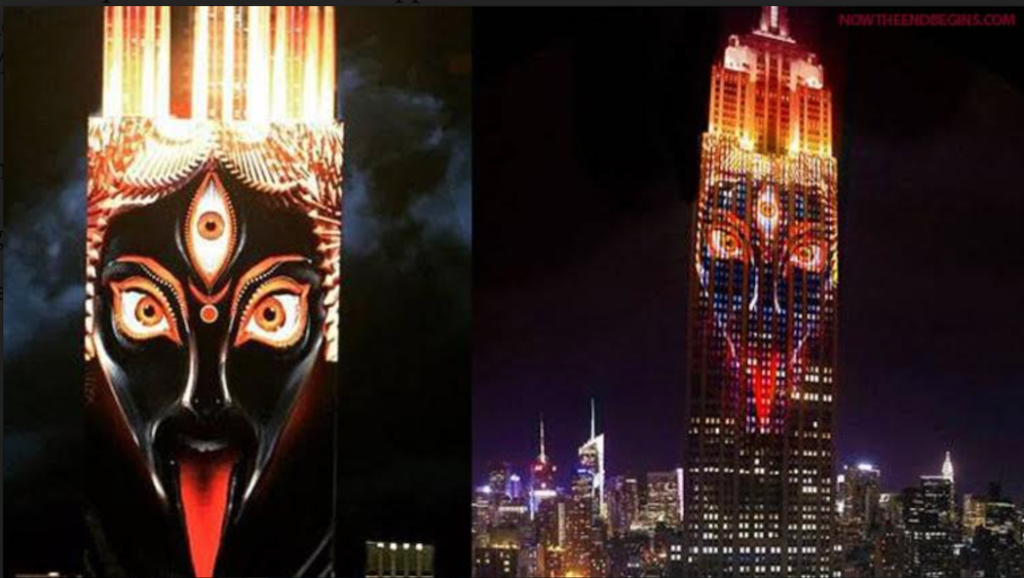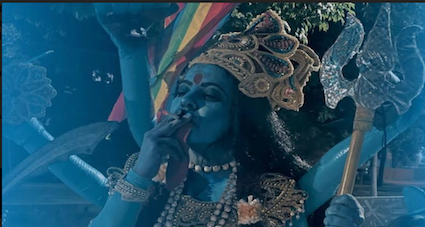The controversy over a poster of a documentary shot by a filmmaker in Canada showing Kali smoking a cigarette and walking on the streets of Toronto has been described by liberals in India as a filmmaker’s artistic freedom.
The liberals have also reminded many (read Hindus) that they need not fight blasphemy, probably because Indian gods and goddesses have been ridiculed and shamed time and again. They have been part of pornographic material, and also featured in strange fashions in cartoons and paintings. The late MF Hussain enjoyed painting Indian goddesses – Durga and Sita to name a few – nude. And then very calmly said it was his artistic freedom. Eventually, it was such indulgence that pushed him out of India to Qatar where he breathed his last.
Around the time the Kali poster started making news, a top editor in India tweeted, the words very relevant for India: “Leena Manimekalai (the filmmaker) can’t imagine Kali smoking while taking a stroll in Toronto because the ship has sailed. Blasphemy is now our shared burden, hypocrisy will be called out. In the West, Charlie Hebedo can draw cartoons, and Snoop Dogg can tear up a page from the Bible to roll a joint.”
And there remains a deeper issue, and the growing need to fight hate propaganda that demeans an entire nation. So let’s get into this big Kali poster debate, the timing of which is both strategic and important. It all started after a poster showed Kali smoking whilst holding a Pride flag.
Kali, the liberal goddess of darkness, is a stout black woman, always perched on a prostrate Shiva. She stares with her red-lined eyes and upraised arms with bright-red palms facing outward. Bengali Hindus believe Kali is the primal cosmic energy of the universe. She is worshipped on the night of Diwali, or the Festival of Lights. It is her night. She is worshipped by many to celebrate her power to destroy evil, as well as the end of the fall of the harvest. There are prayers, fireworks and feasts.
But she has never smoked a cigarette, at least there are no such images. Nor has she been offered one by her devotees. In Dakhineswar on the outskirts of Kolkata where we the most popular Kali temple is located, you cannot joke with cigarettes or cigars.
Manimekalai, through the poster, has reinforced what many claim are negative stereotypes of Hindu society and culture, implanted in India’s academic psyche by colonialists.
Manimekalai is not new to controversies. She has often used a strange, deep-rooted colonial contempt to earn her marbles. She once made a documentary Maadathy: An Unfairy Tale, and claimed it was based on ritualistic prostitution and child sex-abuse allegedly prevalent amidst a particular Dalit community in Tamil Nadu. The movie was screened across the US, especially in functions organised by the Indian Muslim Council. Everyone had a great laugh.
But what was the reality? The documentary turned out to be a one-sided propaganda, lacking genuine details. Worse, the girl portrayed as Mathamma was one Amutha, a school student. Dalit organisations in Tamil Nadu probed the matter and found a number of non-government organisations – in the garb of portraying impoverished Dalit communities – were showing their deities of Dalits as sex workers.
As usual, the dustup got drowned in a million other breaking headlines filling India every day, every week.
Jokes about Kali or her obnoxious portrayal has continued for long.
The Steven Spielberg series, Indiana Jones & The Temple of Doom, depicted Kali as a bloodthirsty goddess worshipped in a secret chamber in Pangot (now in Uttarakhand). The movie, released in 1984, was banned in India. ABC News of Australia said horror was on the map for Temple of Doom because Lucas wanted to match the dark tone of his other trilogy, Star Wars, and its sequel, The Empire Strikes Back. He also wanted to make it a prequel: Temple of Doom is set in 1935, a year before Raiders. Spielberg, for his part, didn’t want to do ghosts because he’d just worked on Poltergeist. But when Lucas, and screenwriters Gloria Katz and Willard Huyck, changed the haunted castle to Indian cults and black magic, he could see their vision.
Temple of Doom became notorious for all these reasons, but perhaps its biggest misstep was its racially insensitive scenes and reliance on Indian stereotypes. Writing for Firstpost, Kuzhali Manickavel said: “As Indians, we are often overcome with pride when we see the rest of the world take notice of us in some way. But perhaps we need to consider what it means when people only notice us on these terms. Would it have been terribly difficult for the Indiana Jones team to get their India stuff right? Probably not. But obviously they felt there was no need to get that stuff right. And that is something worth thinking about.”
In the Halloween of 2013, Supermodel Heidi Klum stirred a controversy by dressing up as Kali. Singer Seal, then married to Klum, dressed up as Angulimaal – an Indian mythical character who chopped off people’s fingers to wear them as a necklace. Klum said she wanted to dress as Kali because she found her a scary Indian goddess. She’s so mean and killed all these different people and had fingers hanging off her and little shrunken heads everywhere.”
Party-goers awarded Klum with the prize for Best Costume on the night. Soon after, the images of Klum dressed as Kali snowballed into a huge controversy, many US-based Hindus demanded an apology from Klum. And then, as expected, the dust settled in no time.
The secretary who did the research for Klum should have told the supermodel that Kali is called the goddess of destruction because she destroys evil. She’s the epitome of pure energy, representing the inner strength and independence of women. Probably the secretary missed all of that. She wanted to find a mean Indian goddess.
But each time, such controversies have been buried by tolerant Hindus who saw such incidents as isolated cases, and chose to ignore insults heaped on one of the world’s largest communities.
Four years after the Klum controversy, Kali on August 13, 2015 took over New York’s Empire State Building as part of an artwork exhibition, titled Projecting Change, by filmmaker Louie Psihoyos to raise awareness about the need to conserve endangered animals. Artist Android Jones designed the fierce portrait of Kali. The images were meant to inspire people to talk about the extinction of some of the world’s most majestic creatures and do their part.

It was seen as a wonderful act of artistic temperament.
The current poster controversy became sensitive because it happened close to the issue of Nupur Sharma, the former Bharatiya Janata Party (BJP) who was censured by the Supreme Court for her remarks that the apex court said triggered communal violence in India.
At an event in Kolkata, Trinamool Congress MP Mohua Moitra dismissed criticisms against the poster by saying Kali is routinely offered liquor and meat, so the protests were totally out of place. It was no big deal for Moitra. Her party immediately censured Moitra and distanced itself from the MP’s remarks.
Moitra should have realised that Tarapith Kali, which she included in her comments, is located inside a crematorium. Liquor is not offered every day, only on rare occasions. Animal sacrifices have been minimised to a large extent. In Dakshineswar temple of Kali – also called Ma Bhabatarini – there are no animal sacrifices, same is the case with Kali at Kalighat that lies close to Nirmal Hriday, the headquarters of Missionaries of Charity.
Some devotees offer Kali liquor and meat. It happens at the Kaal Bhairav temples also. But it all happens in the sacred context of veneration of the devotee and the deity, it does not happen in the commercial context of a film, or a director’s artistic freedom. So a definition of Kali cannot be made in one, quick sweep which the TMC MP attempted. She is from Bengal and she should have known about the Kali temple in Tarapith. She should have known about various reincarnations of the goddess.
Top officials of the museum in Canada where the Kali documentary was screened, have apologised to the Indian government.
That is a very strong signal. It has come at the right time.
(Shantanu Guha Ray is the Asia Editor of Central European News & Zenger News and an award-winning author)


